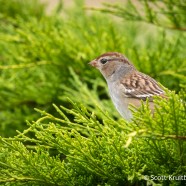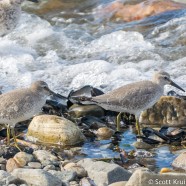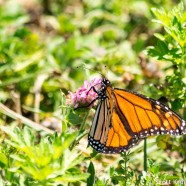Immature White-crowned Sparrow
This immature White-crowned Sparrow is one of many that I have seen this fall in what I feel like has been a strong season for the species. While I have only spotted a few adults, the number of young birds that I recorded thus far has been impressive, but that is not exactly a statistically significant determination! What is your general impression for them this year? Is there a species you feel has been especially abundant? Scott Kruitbosch Conservation & Outreach Coordinator
Read MoreFall Field
Here are some more seasonal shots to get you into the fall mood – a Field Sparrow (Spizella pusilla) from a couple of days ago during a busy migration time for the species. They will pass through the eastern U.S. in good numbers in the autumn with some staying into the winter if they find an acceptable field or other open space with plenty of seeds. They are certainly declining overall in the east because we have far fewer fields than we used to as our natural areas often revert back to forest with the decline of agriculture combined with the continued rise of suburbia. Other remaining...
Read MoreRed Knots
Last evening we found these juvenile Red Knots on the beach at Stratford Point along with Black-bellied Plovers, Semipalmated Sandpipers, Semipalmated Plovers and our first of fall Dunlin. In 2014, the U.S. Fish & Wildlife Service announced that the rufa subspecies of Red Knot was officially added to the United States Endangered Species Act, designated as “threatened”. We are already identifying the most significant staging and feeding areas in Connecticut through our work in the Audubon Alliance for Coastal Waterbirds, and we know this is a very important location for them. It is so...
Read MoreLimosa Harlequin Toad (Atelopus limosus) & RTPI in New Scientist
In the 60 years that the illustrious journal New Scientist has been around they’ve never run a photo-led feature. I’m very proud and honored that they decided to break with that tradition with a story on our work with endangered frogs in Panama. Our research on a population of the exceedingly rare Limosa Harlequin Toad (Atelopus limosus) in Cocobolo Nature Reserve in Panama will hopefully give us more information on why these frogs are seemingly doing alright while its surrounding populations are going extinct. And with some luck, that information can help direct conservation...
Read MoreMonarchs Moving
It is really starting to turn into a good couple of weeks for Monarch butterflies in their expected migratory hotspots, especially along the Atlantic coast, with more individuals like this one being seen feeding and flying every day. Whether it is on a clover, some goldenrod, a sunflower, coneflowers or many more pollinator plants not coated in chemicals these insects are getting the fuel they need to keep moving south. Sunny and calm weather means conducive conditions for flights, and likely means more of them survive their journey. I don’t know about you but the fact they have become...
Read More








